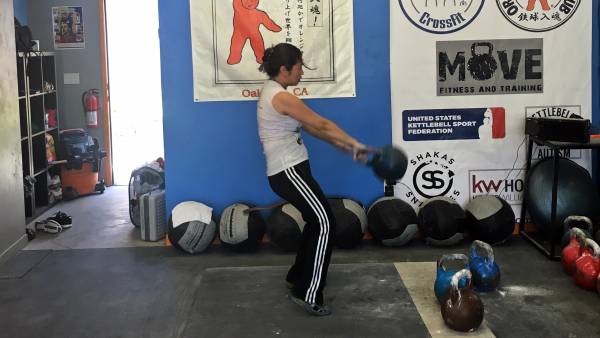Like in all sports, kettlebell sport demands a high-level of technical proficiency. However, unlike other strength sports, the repetitive nature of kettlebell sport will magnify any holes or flaws in your technique over the duration of the set. Millimeter adjustments can have profound effects on your results. So it should be no surprise that elite kettlebell sport athletes have practiced thousands and thousands of reps to perfect their discipline.
Anatomy places a huge role in your expression of the sport lifts. For example, limb length and relative length of the humerus have a huge impact on your rack position. Athletic background, strengths, and weaknesses also influence your style.
But while we see variations in style, the principles stay the same. Whether you’re a lightweight or a heavyweight, tall or short, the following corrections to common technical errors in the kettlebell sport lifts still apply.
Pointers from a qualified coach can help you perfect your technique.
Common Errors – Long Cycle (Clean and Jerk): 1. Hinging Too Early in the Drop
This mistake occurs when you hinge at the hip before allowing your arms to regain connection with the hips. As a result, the load is transferred primarily to the lower back instead of the legs and forces the kettlebells into a more vertical trajectory. You must use more upper body on the next clean to get the bells to the chest.
Instead, as the bells come forward, keep the shoulders back. This will ensure that the hips stay forward. Wait until the forearms are straight and connected with the hips as you transition into the backswing.
Common Errors – Long Cycle (Clean and Jerk): 2. Using Too Much Biceps in the Clean
The majority of the power in the clean should come from the legs. However, many beginning (or tired) lifters may incorrectly rely on the upper body, especially the biceps, to pull the weight to the chest. Consequently, the biceps may get too pumped, which makes the rack position much less restful. Additionally, overly worked arm muscles will undoubtedly cause you to fatigue in the overhead position.
Try to imagine your arms as ropes – loose and relaxed. Feel your legs working as you bring the bells from the apex of the back swing through to the acceleration pull. You know you’re doing it right if it feels effortless.
Common Errors – Long Cycle (Clean and Jerk): 3. Clean to Chest Is Too High
Using too much power or pulling too early may cause the bells to come in high on the chest, instead of directly into the rack position. In both cases, you waste precious energy, first in the clean, and then when making the adjustment to lower the bells into the rack position.
Wait until the bells have passed through the legs before starting the acceleration pull. Then focus on the elbows hitting the hips first, and then bringing the bells to the rack.
Sergei Merkulin, Honored Master of Sport, slow-motion Long Cycle technique
Common Errors – The Jerk: 1. Holding the Breath Overhead
There should never be a moment in any of the kettlebell sport lifts when you are holding your breath. Instead, air should flow freely and constantly, just like in any cyclical sport. Holding your breath when the bells are overhead creates unnecessary tension, which will transfer into the muscles and speed up fatigue. Make sure that you are relaxed in every part of the lift, and one of the best ways to do so is to check is with the breath.
In addition to addressing any mobility limitations, consider adding some overhead holds at the end of a workout to practice relaxation. Use competition weight, hold for 40-60 seconds, and move around. Shake out the legs, walk around the gym, or even try partial squats.
Common Errors – The Jerk: 2. Palms Facing Forward
Another common overhead position error is allowing the palms to face forward (or thumbs pointed towards each other) during lockout. This position prevents the triceps from relaxing, which means they’ll fatigue quicker. Further, this positions the bells directly over your head, which can be unfortunate if the triceps do give out. Please trust me – dropping a 32kg (70lb) kettlebell on your head does not feel good.
Keep your thumbs pointing back as much as possible when in the overhead position. The position of your hands should essentially be the same as in the rack position – thumbs back in rack, thumbs back in overhead without rotation. Practicing overhead holds and improving any mobility issues will help.

Can you spot the technique fault?
Common Errors – The Jerk: 3. Losing Connection in the Bump
Many lifters who have trouble finding a restful rack position (as if it truly exists!) often lose their hip connection in the first dip of the jerk. As a result, the bells shift or bounce in the rack before the bump and movement loses a lot of power.
Feeling the elbows on the hip or on the edge of the belt can provide a kinesthetic cue to keep that connection through the first dip. Additionally, focusing on launching the elbows with the hips instead of the kettlebells may help. I try to imagine a spring coiling straight down – building tension with compression – and then releasing to generate a powerful bump.
Alexander Khvostov, jerk technique.
Common Errors – The Snatch: 1. Throwing the Hips Forward in the Swing
Many lifters who found their way to kettlebell sport via hard-style often make the mistake of throwing the hips forward when performing swings or snatches. This forces the bell away from the lifter and he or she must overcome the trajectory by pulling the bell back and up by way of the upper back and working arm, which will heavily tax the grip.
Your body should always be in balance with the kettlebell – the bell coming forward along with the hips will just pull your weight forward even further. Instead, keep the hips back and let the legs to the work. Then you can utilize your bodyweight by sitting back to assist in the acceleration of the pull.

If you’re a hard-style lifter, learning to let your legs do the work might take some getting used to.
Common Errors – The Snatch: 2. Pulling Too Early
Similarly to the clean, pulling too early in the snatch will fatigue the upper back, arms, and grip especially. This happens when you start the acceleration pull before the kettlebell has passed through the legs.
As a drill, try practicing high swings to understand the timing of the acceleration pull. As you swing, wait until the bell comes to just below hip level before sitting back and pulling the bell up the eye level. Work in sets of at least 30 reps. Your legs should be on fire.
Common Errors – The Snatch: 3. Not Using Rotation in the Acceleration Pull
Unlike the clean, the snatch is a unilateral movement, which allows you to use your body’s rotational power to assist in the pulling phase. This is accomplished by pushing off the toes on the weighted side to shift that side’s hip and shoulder back.
Many lifters miss out on this extra power by keeping the trajectory of the bell in the sagittal plane. However, utilizing that rotational power should make the movement easier and more efficient, which translates to more reps.
Anton Anasenko, Honored Master of Sport, slow-motion snatch technique.
Dial in the Details
Using a mirror and recording video of training sets are extremely helpful in diagnosing technical mistakes. Even if you train under the eyes of a very skilled coach, tools like a mirror and a camera can help resolve any discrepancies between what you feel and what you or your coach sees.
If you find yourself making one or more of these common mistakes, it may be worthwhile to drop back down to lighter kettlebells to work on technique. Once you’ve mastered the movement, increase the weight slowly – ideally in 1-2kg increments – until you reach your competition weight.
A high level of technical proficiency is important in any sport. The high-rep nature of kettlebell sport means any error or extra tension, no matter how slight, will be compounded over a ten-minute set. Prioritizing technical efficiency in all phases of the lifts is the key to increasing your results in the long run.
You’ll Also Enjoy:
- An Introduction to Kettlebell Sport Training Methodologies
- The Beginner’s Guide to Competing in Kettlebell Sport
- 8 Tips for Success for Kettlebell Sport Athletes
- New on Breaking Muscle Today
Photos courtesy of Chris Doenlen.






